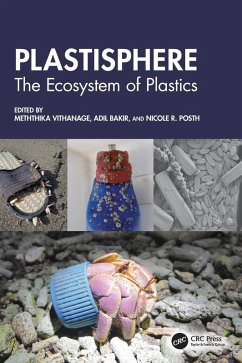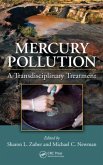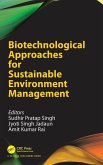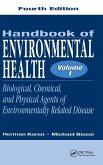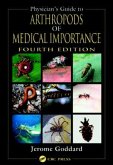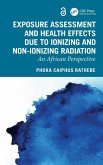Plastisphere
The Ecosystem of Plastics
Herausgeber: Vithanage, Meththika; Posth, Nicole R.; Bakir, Adil
Plastisphere
The Ecosystem of Plastics
Herausgeber: Vithanage, Meththika; Posth, Nicole R.; Bakir, Adil
- Gebundenes Buch
- Merkliste
- Auf die Merkliste
- Bewerten Bewerten
- Teilen
- Produkt teilen
- Produkterinnerung
- Produkterinnerung
This book examines the plastisphere and reveals a secret world of microbes that have adapted to live on plastic surfaces. It explains the ecological effects of plastic pollution, health concerns, microbial ecology, mitigation techniques, and advocates sustainable solutions. Readers will explore its mysteries in this thought-provoking book.
Andere Kunden interessierten sich auch für
![Mercury Pollution Mercury Pollution]() Mercury Pollution236,99 €
Mercury Pollution236,99 €![Sustainable Carbon Capture Sustainable Carbon Capture]() Sustainable Carbon Capture88,99 €
Sustainable Carbon Capture88,99 €![Design of Fishways and Other Fish Facilities Design of Fishways and Other Fish Facilities]() Charles H. ClayDesign of Fishways and Other Fish Facilities264,99 €
Charles H. ClayDesign of Fishways and Other Fish Facilities264,99 €![Biotechnological Approaches for Sustainable Environment Management Biotechnological Approaches for Sustainable Environment Management]() Biotechnological Approaches for Sustainable Environment Management223,99 €
Biotechnological Approaches for Sustainable Environment Management223,99 €![Handbook of Environmental Health, Volume I Handbook of Environmental Health, Volume I]() Herman KorenHandbook of Environmental Health, Volume I324,99 €
Herman KorenHandbook of Environmental Health, Volume I324,99 €![Water Well Rehabilitation Water Well Rehabilitation]() Neil MansuyWater Well Rehabilitation169,99 €
Neil MansuyWater Well Rehabilitation169,99 €![Exposure Assessment and Health Effects Due to Ionizing and Non-Ionizing Radiation Exposure Assessment and Health Effects Due to Ionizing and Non-Ionizing Radiation]() Phoka Caiphus RathebeExposure Assessment and Health Effects Due to Ionizing and Non-Ionizing Radiation112,99 €
Phoka Caiphus RathebeExposure Assessment and Health Effects Due to Ionizing and Non-Ionizing Radiation112,99 €-
-
-
This book examines the plastisphere and reveals a secret world of microbes that have adapted to live on plastic surfaces. It explains the ecological effects of plastic pollution, health concerns, microbial ecology, mitigation techniques, and advocates sustainable solutions. Readers will explore its mysteries in this thought-provoking book.
Produktdetails
- Produktdetails
- Verlag: CRC Press
- Seitenzahl: 384
- Erscheinungstermin: 30. Juni 2025
- Englisch
- Abmessung: 260mm x 183mm x 25mm
- Gewicht: 915g
- ISBN-13: 9781032717807
- ISBN-10: 1032717807
- Artikelnr.: 72701671
- Herstellerkennzeichnung
- Libri GmbH
- Europaallee 1
- 36244 Bad Hersfeld
- gpsr@libri.de
- Verlag: CRC Press
- Seitenzahl: 384
- Erscheinungstermin: 30. Juni 2025
- Englisch
- Abmessung: 260mm x 183mm x 25mm
- Gewicht: 915g
- ISBN-13: 9781032717807
- ISBN-10: 1032717807
- Artikelnr.: 72701671
- Herstellerkennzeichnung
- Libri GmbH
- Europaallee 1
- 36244 Bad Hersfeld
- gpsr@libri.de
Meththika Suharshini Vithanage's contribution to science has been recognized by The World Academy of Sciences (TWAS) presenting the Fayzah M. Al-Kharafi award in 2020. She is listed as a Highly Cited Researcher in 2021 by Clarivate. She is a Fellow of the National Academy of Sciences, Sri Lanka and Institute of Chemistry, Ceylon. She was selected as one of the Early Career Women Scientists by the Organization for Women Scientists in Developing Countries, Italy. Additionally, she received the Best Graduate Researcher Award for Natural Hazards by the American Geophysical Union in 2010. Her outstanding performance in research publications was recognized by the Presidential Awards, Sri Lanka for consecutive 8 years from 2011. Adil Bakir is a Principal Scientist at the Centre for Environment, Fisheries, and Aquaculture Science (Cefas) in the UK. He has been involved in the field of microplastic research for about 10 years, starting as a postdoctoral researcher for a Defra funded project at Plymouth University in the UK. Dr. Bakir joined the marine litter team at Cefas in 2018 and is currently leading the Cefas microplastic laboratory aiming at developing faster and cheaper techniques for the monitoring of microplastics in environmental matrices. Adil is also co-leading the OSPAR microplastic expert group (MPEG) and is currently being involved in the ICES working group on Marine Litter. Nicole R. Posth is an Associate Professor of Geomicrobiology in the Sedimentary Systems Research Group at the University of Copenhagen. She is head of the Geomicrobiology & Biogeochemistry Lab focused on the interactions between microorganisms, minerals, and plastics mediated within biogeochemical cycles in water and sediment at the macro, micro and nanoscale. She is a geomicrobiologist and sediment biogeochemist studying microbial element cycling, biomineralization, and microbe-surface interactions. Bridging field and laboratory experiments, her projects range from interpreting the role of microorganisms in the evolution of life on Earth to the impact of microbial life in driving biogeochemical cycles in the Anthropocene.
1. Global Microplastic Cycle in The Ecosphere. 2. Plastic-Associated
Contaminants. 3. Microbiome in Atmospheric Microplastics and Microplastic
Deposition on Symbiotic Organisms. 4. Phyllosphere as a Signature of
Microplastic Deposition in Peri-Urban Environments. 5. Exploring the
Microbiome of the Marine Microplastisphere: Implications for Microplastic
Fate and Ecological Impacts. 6. Plastisphere Community Assemblage in
Freshwater. 7. Biofilm Dynamics and Environmental Implications on Plastic
Surfaces. 8. How Do Microplastics Distribute through Freshwater Ecosystems?
Which Biota, Feeding Groups, and Trophic Levels are Most at Risk?. 9.
Plastisphere in Aquatic Food Production Systems and Seafood Safety. 10.
Community Ecology and Gene Flow within Biofilms formed on Plastic Surfaces.
11. Plastic Pollution in Macrophyte Systems: Impacts on Habitat Integrity.
12. Rhizobiome of Terrestrial Plastisphere. 13. Plant Health Effects of
Terrestrial Plastisphere. 14. Beyond Biofilm - The Role of Bio-Minerals and
Metals in the Plastisphere - Implications for Elemental Cycling,
Biogeochemical Processes, and Human Health. 15. Engineering Microbiosphere
for Degradation of Plastics. 16. Environmental Health Impact of
Plastisphere. 17. Insights into Microbial Enzyme-Mediated Hydrolysis of
Fossil-Based Polymers in Plastisphere: Prospects for Environmental
Sustainability. 18. Plastisphere as a Vector for Pathogenic Microbes and
Antibiotic Resistance. 19. Plastisphere Nomads: An Overview of Organism
Dispersal via Marine Plastic Litter. 20. Data Gaps in Assessing the Risks
of Microplastics into the Food Chain.
Contaminants. 3. Microbiome in Atmospheric Microplastics and Microplastic
Deposition on Symbiotic Organisms. 4. Phyllosphere as a Signature of
Microplastic Deposition in Peri-Urban Environments. 5. Exploring the
Microbiome of the Marine Microplastisphere: Implications for Microplastic
Fate and Ecological Impacts. 6. Plastisphere Community Assemblage in
Freshwater. 7. Biofilm Dynamics and Environmental Implications on Plastic
Surfaces. 8. How Do Microplastics Distribute through Freshwater Ecosystems?
Which Biota, Feeding Groups, and Trophic Levels are Most at Risk?. 9.
Plastisphere in Aquatic Food Production Systems and Seafood Safety. 10.
Community Ecology and Gene Flow within Biofilms formed on Plastic Surfaces.
11. Plastic Pollution in Macrophyte Systems: Impacts on Habitat Integrity.
12. Rhizobiome of Terrestrial Plastisphere. 13. Plant Health Effects of
Terrestrial Plastisphere. 14. Beyond Biofilm - The Role of Bio-Minerals and
Metals in the Plastisphere - Implications for Elemental Cycling,
Biogeochemical Processes, and Human Health. 15. Engineering Microbiosphere
for Degradation of Plastics. 16. Environmental Health Impact of
Plastisphere. 17. Insights into Microbial Enzyme-Mediated Hydrolysis of
Fossil-Based Polymers in Plastisphere: Prospects for Environmental
Sustainability. 18. Plastisphere as a Vector for Pathogenic Microbes and
Antibiotic Resistance. 19. Plastisphere Nomads: An Overview of Organism
Dispersal via Marine Plastic Litter. 20. Data Gaps in Assessing the Risks
of Microplastics into the Food Chain.
1. Global Microplastic Cycle in The Ecosphere. 2. Plastic-Associated
Contaminants. 3. Microbiome in Atmospheric Microplastics and Microplastic
Deposition on Symbiotic Organisms. 4. Phyllosphere as a Signature of
Microplastic Deposition in Peri-Urban Environments. 5. Exploring the
Microbiome of the Marine Microplastisphere: Implications for Microplastic
Fate and Ecological Impacts. 6. Plastisphere Community Assemblage in
Freshwater. 7. Biofilm Dynamics and Environmental Implications on Plastic
Surfaces. 8. How Do Microplastics Distribute through Freshwater Ecosystems?
Which Biota, Feeding Groups, and Trophic Levels are Most at Risk?. 9.
Plastisphere in Aquatic Food Production Systems and Seafood Safety. 10.
Community Ecology and Gene Flow within Biofilms formed on Plastic Surfaces.
11. Plastic Pollution in Macrophyte Systems: Impacts on Habitat Integrity.
12. Rhizobiome of Terrestrial Plastisphere. 13. Plant Health Effects of
Terrestrial Plastisphere. 14. Beyond Biofilm - The Role of Bio-Minerals and
Metals in the Plastisphere - Implications for Elemental Cycling,
Biogeochemical Processes, and Human Health. 15. Engineering Microbiosphere
for Degradation of Plastics. 16. Environmental Health Impact of
Plastisphere. 17. Insights into Microbial Enzyme-Mediated Hydrolysis of
Fossil-Based Polymers in Plastisphere: Prospects for Environmental
Sustainability. 18. Plastisphere as a Vector for Pathogenic Microbes and
Antibiotic Resistance. 19. Plastisphere Nomads: An Overview of Organism
Dispersal via Marine Plastic Litter. 20. Data Gaps in Assessing the Risks
of Microplastics into the Food Chain.
Contaminants. 3. Microbiome in Atmospheric Microplastics and Microplastic
Deposition on Symbiotic Organisms. 4. Phyllosphere as a Signature of
Microplastic Deposition in Peri-Urban Environments. 5. Exploring the
Microbiome of the Marine Microplastisphere: Implications for Microplastic
Fate and Ecological Impacts. 6. Plastisphere Community Assemblage in
Freshwater. 7. Biofilm Dynamics and Environmental Implications on Plastic
Surfaces. 8. How Do Microplastics Distribute through Freshwater Ecosystems?
Which Biota, Feeding Groups, and Trophic Levels are Most at Risk?. 9.
Plastisphere in Aquatic Food Production Systems and Seafood Safety. 10.
Community Ecology and Gene Flow within Biofilms formed on Plastic Surfaces.
11. Plastic Pollution in Macrophyte Systems: Impacts on Habitat Integrity.
12. Rhizobiome of Terrestrial Plastisphere. 13. Plant Health Effects of
Terrestrial Plastisphere. 14. Beyond Biofilm - The Role of Bio-Minerals and
Metals in the Plastisphere - Implications for Elemental Cycling,
Biogeochemical Processes, and Human Health. 15. Engineering Microbiosphere
for Degradation of Plastics. 16. Environmental Health Impact of
Plastisphere. 17. Insights into Microbial Enzyme-Mediated Hydrolysis of
Fossil-Based Polymers in Plastisphere: Prospects for Environmental
Sustainability. 18. Plastisphere as a Vector for Pathogenic Microbes and
Antibiotic Resistance. 19. Plastisphere Nomads: An Overview of Organism
Dispersal via Marine Plastic Litter. 20. Data Gaps in Assessing the Risks
of Microplastics into the Food Chain.

